Train Like the Pros: Top 14 Military Dog Commands
Train Like the Pros: Top 14 Military Dog Commands
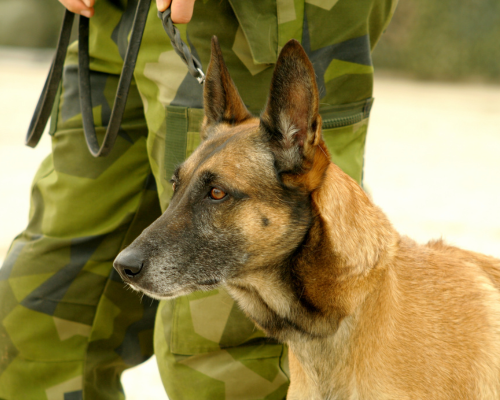
Vet Reviewed

By: Sarah Hodgson
December 12, 2023
Table of Contents
If you’ve ever seen a military dog in action, you know just how incredible they are. From laser-sharp focus to unbelievable discipline, these dogs are some of the most skilled working animals in the world. What makes them so impressive isn’t just their natural intelligence, but the intensive training they go through.
Military dogs are trained to respond instantly to specific commands that can mean the difference between success and failure in the field. Even if you’re not raising a military working dog, these commands offer fascinating insight into how obedience, control, and trust are built between dogs and their handlers.
In this article, we’ll break down 14 essential military dog training commands. We'll go over what they are and provide a short explanation on how you might train your dog at home to perform these super cool commands.
1. Attention
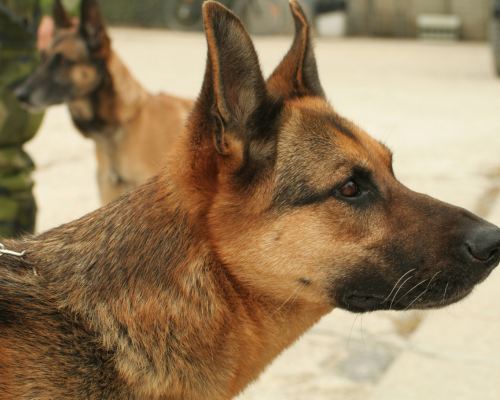
The very first step in military dog training is teaching focus. The “Attention” command trains the dog to maintain eye contact with its handler and await further instruction.
How To Teach?
To start, stand in front of your dog and give the verbal command "Attention" while maintaining eye contact. Reward your dog with praise or treats when they respond correctly by looking directly at you. Consistency is key, so practice this command in various environments to reinforce the behavior.
This builds the foundation for every other command that follows.
2. Sit

Simple but powerful, the “Sit” command keeps the dog steady and under control. In high-stress scenarios, this command ensures the dog pauses so the handler can quickly assess the situation.
How To Teach?
Begin by holding a treat close to your dog's nose and slowly raise it above their head. As their nose follows the treat, their rear end will naturally lower into a sitting position. Once they are seated, praise them and give the verbal command "Sit." Repeat this exercise regularly until your dog responds promptly to the command, even without the treat incentive.
3. Stay
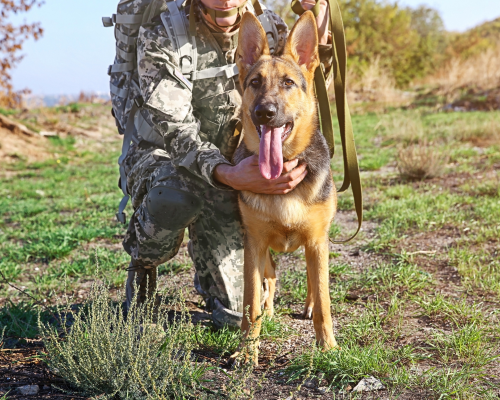
Once seated, “Stay” teaches patience and restraint. Whether it’s waiting at a distance or holding position in a crowded area, this command reinforces discipline and prevents impulsive behavior.
How To Teach?
Start with your dog in the sitting position and place your open palm in front of their face, as if signaling them to stop. Give the verbal command "Stay" while taking a step back. If your dog remains still, return to them, praise them, and reward them with a treat. Gradually increase the distance and duration of the stay, ensuring your dog stays in place until released.
4. Down
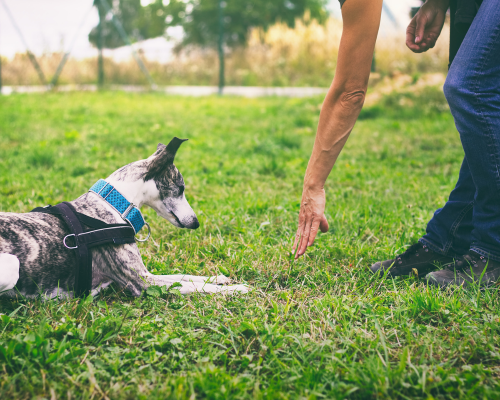
The “Down” command lowers the dog to the ground, minimizing their visibility and keeping them calm. In tactical situations, being able to stay low can be vital for safety.
How To Teach?
Begin by commanding your dog to sit. Then, hold a treat close to their nose and lower it to the ground between their paws. As they follow the treat, their body will naturally lower into a lying position. Once they are down, give the verbal command "Down" and reward them with praise or a treat. Practice this command in different environments to ensure your dog can respond reliably.
5. Attack
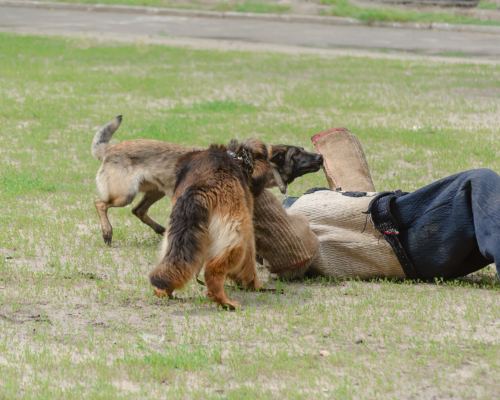
Perhaps the most well-known (and controversial) command, “Attack” instructs a dog to engage a target. Because of its intensity, this command is taught only by expert trainers, with strict safety protocols in place.
As it's a harmful command we won;t go over on how to teach your dog this command in this article. However. the process involves teaching the dog to apprehend or immobilize a target on command.
6. Come
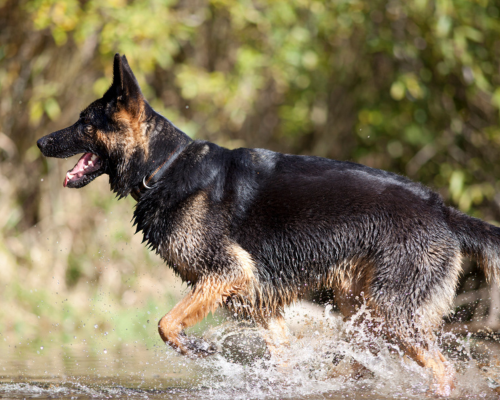
Reliable recall is non-negotiable in the field. The “Come” command ensures that no matter the distraction, the dog will return immediately to the handler.
How To Teach?
Teaching the "come" command starts with a leash and collar. Begin by placing the dog on a leash and gently pulling them towards you while saying "come" in a firm and clear voice. As the dog moves towards you, reward them with praise and a treat. Repeat this exercise multiple times, gradually increasing the distance between you and the dog. Eventually, the dog will associate the command "come" with returning to the handler and will respond even without the use of a leash.
7. Jump

From scaling walls to leaping over debris, military dogs must navigate obstacles with agility. The “Jump” command prepares them for real-world missions where terrain can be unpredictable.
How To Teach?
Begin by commanding the dog to sit, then hold a treat above their head and say "jump" in a clear and assertive tone. As the dog reaches for the treat, raise it slightly higher to encourage them to jump. Reward the dog with praise and treats when they successfully jump. Gradually increase the height of the obstacle to challenge the dog and reinforce the command.
8. Bite
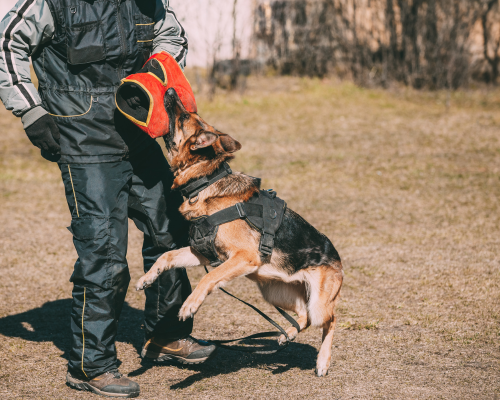
Similar to “Attack,” the “Bite” command is part of apprehension training. Dogs learn to bite and hold until instructed otherwise, always under professional supervision.
How To Teach? (Should be taught by professional trainers only)
The process typically involves the use of a bite sleeve or a specialized training apparatus. The dog is trained to respond to a specific command, such as "bite" or "engage," and directed towards the target.
9. Release
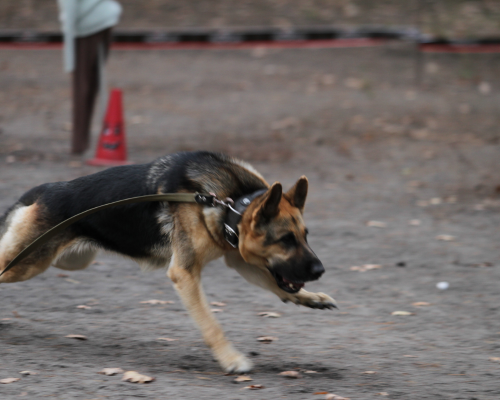
Equally important is knowing when to stop. The “Release” command ensures that the dog disengages immediately, whether from a target or an object.
How To Teach?
Begin by commanding the dog to hold an object, such as a toy or a bite sleeve. As the dog firmly holds the object, use a distinct command, such as "release" or "let go," while gently prying their mouth open. Reward the dog with praise and treats when they release the object willingly. Consistent repetition and positive reinforcement are key to mastering this command.
10. Guard
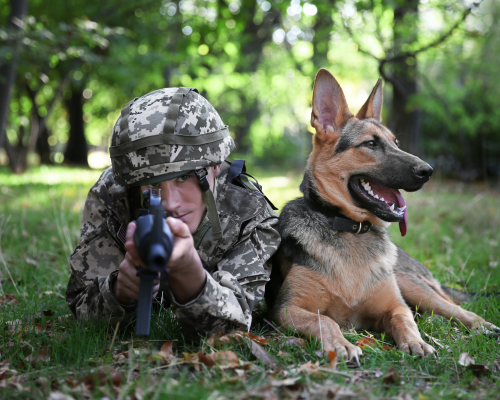
The “Guard” command trains dogs to protect a designated area or person, often with a commanding bark or defensive posture. It’s a powerful deterrent when presence alone is enough to prevent conflict.
How To Teach?
To teach a dog a guard command, start by choosing a specific word like “guard” and use it consistently while rewarding alert behavior with treats or praise. Pair the command with a hand signal and practice in a quiet, controlled environment before introducing distractions. Always ensure the dog remains under control, alerting without aggression, and reinforce the behavior with short, positive training sessions.
11. Quiet
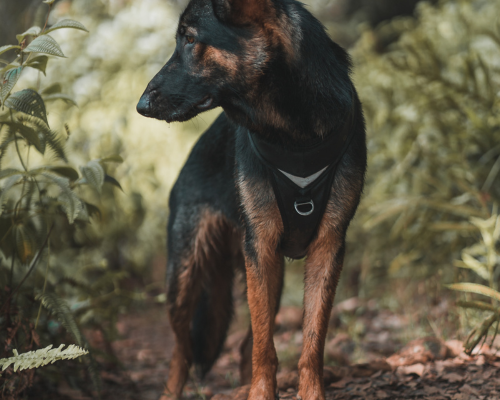
Silence can be just as important as action. With the “Quiet” command, dogs stop barking instantly—critical during covert missions where stealth matters most.
This command is particularly useful in situations where the element of surprise is crucial, such as during covert missions or ambushes.
How To Teach?
To teach a dog the “quiet” command, wait until the dog is barking or making noise and calmly say “quiet” while holding a treat. When the dog stops barking, immediately reward it with the treat and praise. Practice this consistently in short sessions until the dog learns to stop on command.
12. Track
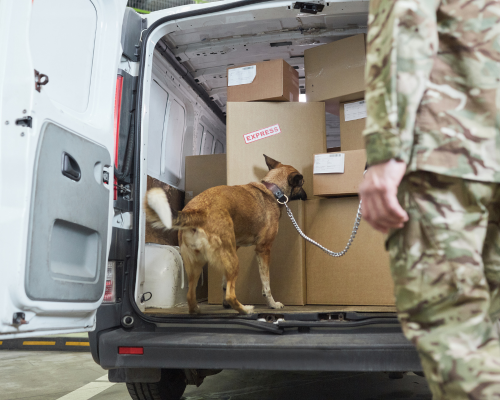
Military dogs have an extraordinary sense of smell. The “Track” command activates this ability, guiding them to follow a scent trail. This is especially valuable in search and rescue or when locating missing persons.
How To Teach?
To teach a dog the “track” command, start by laying a scent trail using a favorite toy or treat and guide the dog to follow it while saying “track.” Reward the dog with praise or a treat each time it follows the trail correctly. Practice regularly, gradually making the trails longer and more challenging to strengthen the dog’s tracking skills.
13. Stand
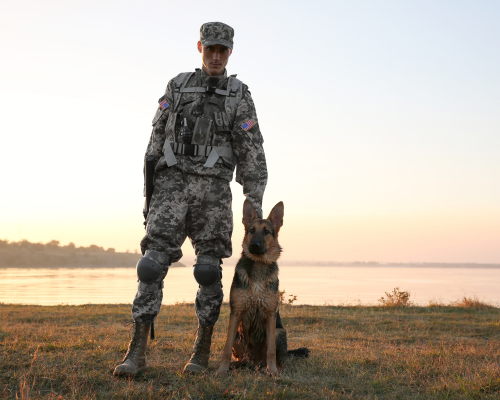
The “Stand” command teaches the dog to remain upright and alert. In some cases, simply being visible and steady can act as a deterrent to potential threats.
How To Teach?
Gently guide the dog into a standing position while saying “stand.” Reward the dog with treats and praise for holding the position. Practice regularly, gradually asking the dog to stand from sitting or lying down until it responds reliably to the command.
14. Fetch
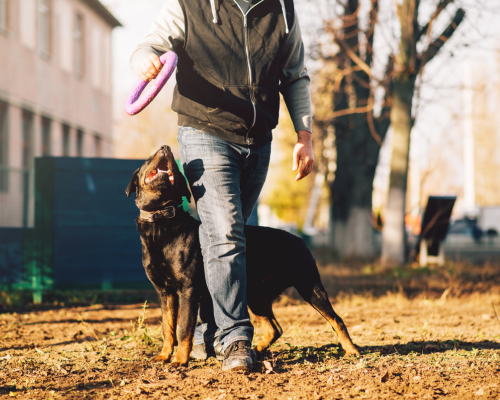
Finally, the “Fetch” command equips dogs to retrieve important items—anything from equipment to sensitive documents—bringing speed and efficiency to military operations.
How To Teach?
Start by showing the dog a toy and saying “fetch” as you throw it a short distance. Encourage the dog to bring the toy back, and reward it with praise or a treat when it returns. Practice consistently, gradually increasing the distance and reinforcing the behavior until the dog fetches reliably.
The Bottom Line,
Military dog training is not just about teaching commands, it’s about building trust, discipline, and communication between handler and dog.
These 14 military dog training commands form the foundation of a well-rounded working dog. From basic obedience like “Sit” and “Stay” to advanced skills like “Attack” and “Track,” each one has a purpose that can literally save lives.
For dog lovers and aspiring trainers, the lesson is clear: training takes time, consistency, and patience. Whether your goal is raising a working dog or simply strengthening the bond with your pet at home, the principles behind military training can inspire us all.

Subscribe to Petfluence!
Get updates on the latest posts and more from Petfluence straight to your inbox.